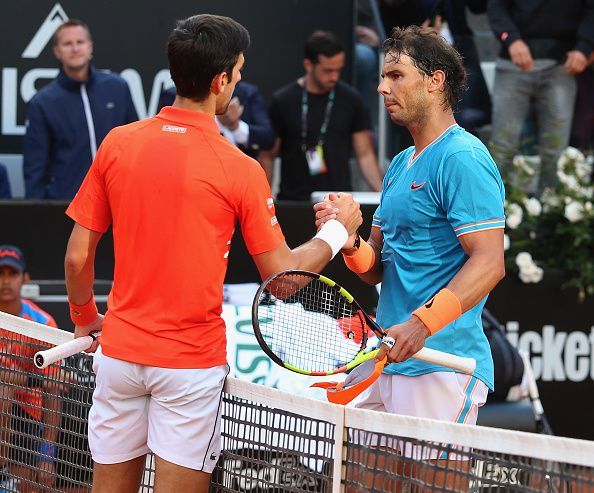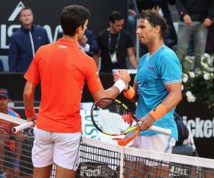Paris (dpa) - Terre battue, red clay or simply the dirt, there are many words at the French Open for the surface that arguably tests players like no other at the tennis grand slams.
And if that wasn't enough, players also have to deal with the fact that every court seems to play a little different at Roland Garros.
It is a matter of personal taste if a player prefers the vast Philippe Chatrier centre court, the tighter Suzanne Lenglen, the legendary round-shaped Court One known as the bullring, or the spanking new Simonne Mathieu which is enclosed by greenhouses.
Superstars Roger Federer, who has now played 400 matches at the majors of which he has won 20, and Rafael Nadal, the 11-time Roland Garros winner with a ridiculous 89-2 match record, mostly play on the first two these days and are experts to talk about them.
"I feel Suzanne Lenglen has always been the more slippery court than Chatrier. I guess the way the base is done, it seems harder at the bottom, and for that reason, it's harder to find grip, you know," Federer said.
"And on centre, it's more - it's just different. It's a bit softer."
Nadal meanwhile also touched on the different dimensions of the courts when he said that "Chatrier is a bit more complicated to play on. This court is very huge. You can sometimes lose your reference marks.
"If you ask me the question on which do I prefer playing, Chatrier, there is no question. I feel more in control. Although I have never lost on Lenglen, either."
Czech second seed Karolina Pliskova meanwhile said "the fastest court was the Simonne Mathieu" while naming Chatrier slow - and all Roland Garros courts slower than those of the build-up events in Rome and Madrid.
Belgium's David Goffin, who lost to Nadal Friday, was on Simonne Mathieu on the first day Sunday and liked it - but just like the other courts.
"The clay is great, as good as the others. It's never easy to build the clay court from scratch, while we have been playing on the others for years, and there they had to start from scratch. They did a beautiful job," he said.
While Simonne Mathieu is brand new, Chatrier underwent a complete rebuild over the past year - except the playing surface itself and its base, which is untouched since 1928 when the likes of Rene Lacoste played in the then new arena.
“It’s the same soil that was there at the beginning; we’ve dug nothing below. The sweat of Monsieur Lacoste is still there underneath," stadium renovation chief Gilles Jourdain recently told the New York Times.
Players notice the tiniest difference as the shape of the surface will influence the bounce of the ball and also the all important sliding.
The latter makes the clay such a difficult surface for many American players who like Australians and Asians learnt the game on hard courts.
Europeans meanwhile grow up on clay, which makes the transition from hard court to clay every April much more natural for them.
Sliding, longer rallies and thus longer matches, and with it the all important mental aspect, are classic clay court ingredients, far more than on hard courts (which are also known as "the great equalizer") and the fast grass.
For German Andrea Petkovic clay court tennis is "like a game of chess" because it requires so much more than brutal power.
"I like clay because it makes the game a little slower and it gives you the opportunity to really use your brains and use tactical choices," she said.
The 2011 semi-finalist didn't however dig deeper and add whether she preferred Chatrier, Lenglen or another court. For her, all that mattered that it was dirt, or red clay, or terre
And if that wasn't enough, players also have to deal with the fact that every court seems to play a little different at Roland Garros.
It is a matter of personal taste if a player prefers the vast Philippe Chatrier centre court, the tighter Suzanne Lenglen, the legendary round-shaped Court One known as the bullring, or the spanking new Simonne Mathieu which is enclosed by greenhouses.
Superstars Roger Federer, who has now played 400 matches at the majors of which he has won 20, and Rafael Nadal, the 11-time Roland Garros winner with a ridiculous 89-2 match record, mostly play on the first two these days and are experts to talk about them.
"I feel Suzanne Lenglen has always been the more slippery court than Chatrier. I guess the way the base is done, it seems harder at the bottom, and for that reason, it's harder to find grip, you know," Federer said.
"And on centre, it's more - it's just different. It's a bit softer."
Nadal meanwhile also touched on the different dimensions of the courts when he said that "Chatrier is a bit more complicated to play on. This court is very huge. You can sometimes lose your reference marks.
"If you ask me the question on which do I prefer playing, Chatrier, there is no question. I feel more in control. Although I have never lost on Lenglen, either."
Czech second seed Karolina Pliskova meanwhile said "the fastest court was the Simonne Mathieu" while naming Chatrier slow - and all Roland Garros courts slower than those of the build-up events in Rome and Madrid.
Belgium's David Goffin, who lost to Nadal Friday, was on Simonne Mathieu on the first day Sunday and liked it - but just like the other courts.
"The clay is great, as good as the others. It's never easy to build the clay court from scratch, while we have been playing on the others for years, and there they had to start from scratch. They did a beautiful job," he said.
While Simonne Mathieu is brand new, Chatrier underwent a complete rebuild over the past year - except the playing surface itself and its base, which is untouched since 1928 when the likes of Rene Lacoste played in the then new arena.
“It’s the same soil that was there at the beginning; we’ve dug nothing below. The sweat of Monsieur Lacoste is still there underneath," stadium renovation chief Gilles Jourdain recently told the New York Times.
Players notice the tiniest difference as the shape of the surface will influence the bounce of the ball and also the all important sliding.
The latter makes the clay such a difficult surface for many American players who like Australians and Asians learnt the game on hard courts.
Europeans meanwhile grow up on clay, which makes the transition from hard court to clay every April much more natural for them.
Sliding, longer rallies and thus longer matches, and with it the all important mental aspect, are classic clay court ingredients, far more than on hard courts (which are also known as "the great equalizer") and the fast grass.
For German Andrea Petkovic clay court tennis is "like a game of chess" because it requires so much more than brutal power.
"I like clay because it makes the game a little slower and it gives you the opportunity to really use your brains and use tactical choices," she said.
The 2011 semi-finalist didn't however dig deeper and add whether she preferred Chatrier, Lenglen or another court. For her, all that mattered that it was dirt, or red clay, or terre









 Home
Home Politics
Politics











